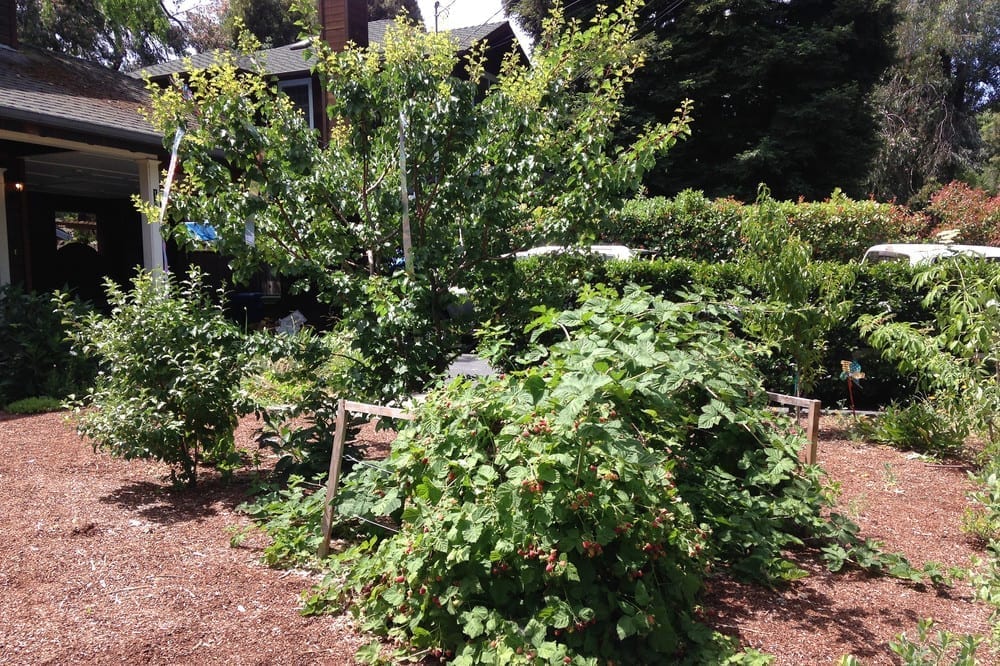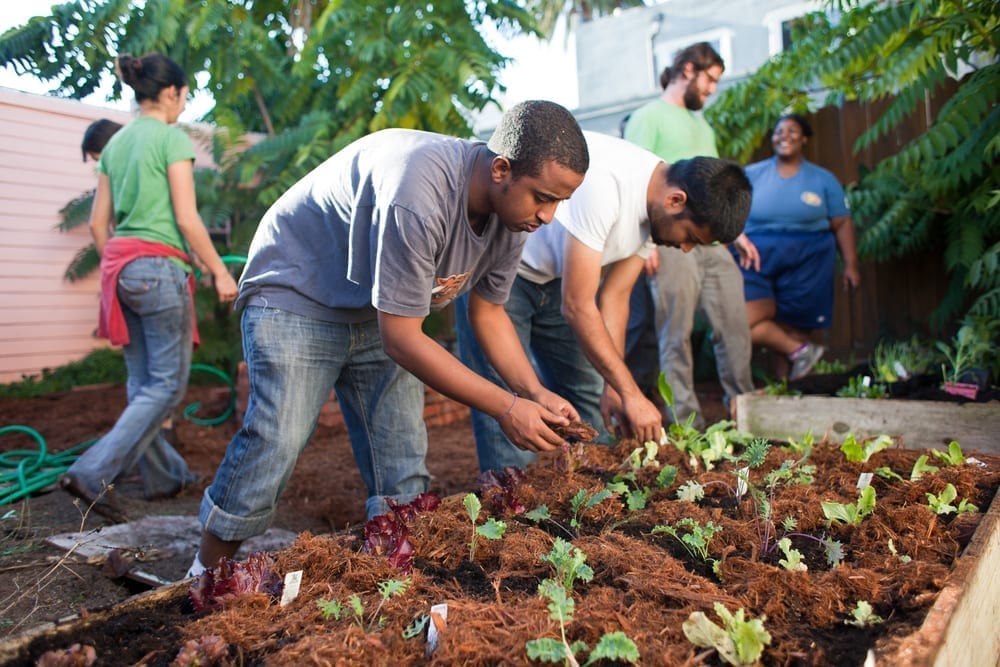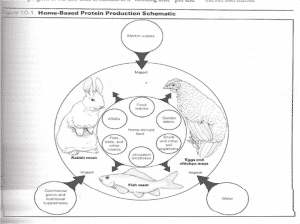Urban Permaculture
What Is Permaculture?
“Permaculture is the conscious design of agriculturally productive ecosystems which have diversity, stability, and resilience of natural ecosystems.” -Bill Mollison
Permaculture is a scientific and artistic method for designing human settlements to meet humanity’s basic needs (healthy food, clean water, shelter, energy, and community) in a way that not only “sustains” but actively regenerates biodiversity and natural resources.
Whether you are designing your own urban plot, a community garden, your whole city block, or a ten thousand acre parcel, Permaculture begins with the premise that by mimicking and working with Nature’s principles, we can design for long-term abundance and healthy habitat for all life, from microscopic soil organisms to humans.
How Permaculture Works
Permaculture begins with close observation, and builds upon thousands of years of practices from around the world that have long enabled communities of people to provide for their basic needs in ways that passively store energy, water, biodiversity, nutrients, … Life…in the landscape.
By working with Nature’s patterns — for example, the way water moves across the landscape, or the way healthy soil micro-organisms break down organic matter — we can refill aquifers, build new topsoil, and help create biodiverse ecosystems in a surprisingly short amount of time. Indigenous peoples from California to India and across the world understood what we have only recently forgotten: that we are part of nature, that are lives are dependent upon the lives of all living beings, and that our collective actions determine whether our descendents experience scarcity or abundance.
We’ve designed most of our farms and cities to shed water and nutrients, rather than to soak them into the landscape. This has resulted in a food system that depends upon unsustainable amounts of groundwater, oil, and toxic inputs for its survival. In far too many places, we are watching humanity turn lush valleys, abundant coastlines, and diverse forests into deserts, or worse, poisoned and deeply scarred landscapes unsuitable for most living beings.
These are well-known and over-studied problems. We know what we are doing wrong. What we need are tangible solutions! So lets do it!
Life seeks to perpetuate itself. It does this by interweaving multiple connections between organisms, so that each organism’s life creates the conditions for life for literally millions of other organisms. The most stable ecological systems are those with the most connections. The role of the permaculture designer then is not to invent anything new, only to arrange life forms in a way that maximizes the numbers of connections between elements, maximizes productivity, and minimizes work and pollution. If done right, a permaculture garden can water itself, build topsoil itself, and grow food itself, while the designer watches and eats! By following some basic design principles, we can design landscapes that will catch and harvest nearly every drop of water to produce food and beauty for decades to come.without much tilling, weeding, or work at all, besides harvesting!
Permaculture Systems…
• Produce more energy than they consume
• Create soils and forests, rather than simply conserving them
• Produce most regional needs
• Recycle or produce nutrients
• Prevent energy from leaving before the basic needs of the whole system are satisfied
The Permaculture Values
1. Care of Earth — this includes all living and nonliving things that share this planet with us.
2. Care of People — to promote self-reliance, holistic heath, and wellbeing for individuals and communities
3. Setting Limits to Consumption — the goal is to leave our earth healthier than we found it.
4. Returning the Surplus — to pass on anything surplus to our needs (labor, money, information, etc.)
Deeply embedded in permaculture is a respect for the “Life Ethic”: all living beings are not only means but also ends. In addition to instrumental value to humans and other living organisms, they have an intrinsic worth.
Permaculture Life Ethics
1. Working With Nature Rather than Against Her
Observe, respect, and work with Nature’s patterns (decay, gravity, contours, etc) to allow Nature to do the work and build fertility for us
2. The Problem is the Solution
Viewing every “problem” as an opportunity. For instance, slug overpopulation is a duck deficiency. A shaded backyard in Northern California is an ideal place for the cultivation of shiitake and oyster mushrooms, rabbits, indian lettuce (Claytonia perfoliata) and salal berries (Gaultheria shallon). Pollution and overpopulation in cities provides the excess “waste” nutrients and human energy we need to transform our cities into abundant and beautiful resources for food and energy.
3. Make the Least Change for the Greatest Possible Effect
Minimize unnecessary effort. Instead of digging up your lawn by hand (an enormous effort that will probably result in the lawn’s regrowth due to the fact that it is very difficult to dig up all the roots), sheet mulch instead! Cover that lawn with biomass, and let the lawn decompose and turn into topsoil with the help of worms, bacteria, and fungi. Nature does the work, and you are left with rich, living topsoil (and a healthy back).
4. Every Element Supports Many Functions (Stacking Functions)
For example, a tree can produce food, provide shade, support bird habitat, filter air pollution, provide a wind break, prevent soil erosion, drop leaves for use as mulch, build soil, soak up water, create beauty, and much more.
5. Every Element is Supported by Other Elements (Planned Redundancy)
Once you have listed all the functions, needs (inputs), and products (outputs) for the elements in your design, you can place elements that support each other together. in the right place. When the needs required by each element are satisfied by the “wastes” of other elements, you’ve just eliminated a lot of work and pollution!
6. Use Native and Perennial Plants Wherever Possible.
Use native plants first, proven (and delicious) low-maintenance perennials next, and annuals third. Native plants are best adapted to your local ecology, and thus require the least maintenance and inputs. Perennial fruits, berries, nuts and vegetables that are adapted to your climate also can be extremely low-maintenance, and they can provide abundant harvests for generations. Annuals are often desired too for their culinary importance and cultural relevance, but these require more effort and care, and must be replanted each season.
7. Relative Location
Time is perhaps an individual’s most precious resource. Use methods of permaculture design to place related and interdependent elements together, and the most used elements closest to your house and along commonly traveled routes.
8. Relationship Between Elements
Bill Mollison says it best:
“Design is a connection between things. It’s not water, or a chicken, or the tree.
It’s how the water, the chicken and the tree are connected. It’s the opposite of what we are taught in school.
Education takes everything and pulls it apart and makes no connections at all.
Permaculture makes the connection because as soon as you have the connection,
you can feed the chicken from the tree.”
– Bill Mollison, co-founder of Permaculture
9. Pollution as an Unused Resource
Pollution is nothing but an overabundance of a resource in the wrong place…an overabundance of nutrients that are not being used by other elements in the system.
By Design…
Interactive Diversity > Stability
Stability > Fertility
Fertility > Productivity
Productivity > Vibrant Local Economies
Local Economy > Community
Community > Culture
Permaculture design emphasizes patterning of landscape, function, and species assemblies.
It asks the question, “Where does this element go? How is best placed for maximum benefit in the system?”
Permaculture Is Made Up of Techniques and Strategies:
– Techniques are how we do things, (one-dimensional).
– Strategies are how and when, (two-dimensional).
– Design is patterning, (multi-dimensional).
Permaculture is all about the science and ethics of design patterning.
Approaches to design:
1. Maps, “where is everything?”
2. Analysis of elements, “how do these things connect?”
3. Sector planning, “where do we put things?”
4. Observational.
5. Experiential.
The Tools
1. Maps: A main tool of a designer, but “the map is never the territory”. Be careful not to design just from maps, no map tells the entire story that can be observed on the ground. A sequence of maps are valuable to see clearly where to place elements: – Water, Access, Structures, Topology etc.
2. The analysis of elements: List the needs, products, and the intrinsic characteristics of each element. Lists are made to try and link the supply needs of elements to the production needs of others.
3. Sector planning: Includes (a) zones (b) sector (c) slope, and (d) orientation
(a) Zones help us place elements in a beneficial relative location. Zone 1 may be your home, bedroom, and bathroom, so you would place things in zone 1 that you use many times per day. Zone 2 may be just out your front door, so place things in zone 2 that you need once a day or more, whereas things go in zone 5 that you only need a few times per year.
(b) Sectors help us understand the flows of energy into the system. Where is the wind coming from? Where is the path of the sun in the summer? In the winter?
(c) Slope analysis helps us to best utilize gravity and water. Can we store that rainwater tank on the highest point possible, to water our gardens using gravity?
(d) Know the path of the sun! Make sure that you have adequate sun exposure in the winter, and shade in the summer.
“The struggle of people against power is the struggle of memory against forgetting.”
-Milan Kundera
Indigenous peoples have long sustained themselves through their intimate connection to their local ecology…the natural patterns, plants, water sources, sources of energy, soils, animal life, etc around them. Exploitation of the earth’s natural resources on a massive global scale, and the introduction of unbalanced economic systems (so-called “Free Trade” agreements) interrupts the stability of local ecologies and economies, and diminishes the ability of local communities to provide for their basic needs. This leads to mass migration and the devastating loss of cultures and place-based knowledges.
Permaculture can help us re-remember the ingenious techniques and strategies that enable humans to provide for our needs in ways that contribute to the overall health and dynamic vibrancy of all living things around us, on which we depend for our own survival. What could be more important than that?
We badly need permaculture in urban environments, and fast! Cities are epicenters of poverty, hunger, unemployment, and pollution…but seen another way, they are also epicenters of resources, nutrients, diversity, and possibility! We have great access in the city to a variety of free, excess nutrients (on a purely scientific caloric level) and materials to build healthy soil and garden infrastructure. Just think about all the uneaten food from supermarkets and restaurants in your neighborhood…these nutrients can be collected and composted to build soil and garden fertility where there once was none. Dense population offers us a ready supply of collaborators, employees, and volunteers, and cuts the shipping mileage from soil to plate to nearly zero. We have paved surfaces such as roofs, sidewalks, and driveways, which we can use to direct water to grow food an fertility. We have a variety of microclimates in which we can grow diverse varieties of food. What we need is innovation, tangible solutions, and successful models that can be replicated in cities across the world. This is the mission of Planting Justice, so please, support this work!
Urban Permaculture Resources
Compost
Constructing a Food Forest
Herb Spiral
Content coming soon.
Insectaries
These flowering plants attract pollinating insects such as bees, butterflies, and hummingbirds, which are needed to spread pollen to turn flowers into fruit!
Others in this group are so strongly scented that they confuse and deter pests.
Here is a list of good insectaries to plant in temperate climates:
- Dill
- Fennel
- Bee Balm
- Lavender
- Rosa Rugosa
- Borage
- Nasturtium
- Anise Hyssop
- Calendula
- Lemon Balm
- Lemon Verbena
- Clover
- Alfalfa
- CA poppy
- Yarrow
- Monkey Flower
- Humming Bird Sage
Mycorhizzal Fungi
INDIGENOUS MYCORRHIZAL FUNGI
Mycorrhizal fungi are an essential part of healthy organic living soil structure and have an incredible symbiotic relationship with plants. They live in the root zones of plants and feed off of other microbes, called nematodes, and convert them to usable nutrients. They act as a sort of glue, holding soil particles and water in a way that creates plenty of air space.
We will collect mycorrhizal fungi from a healthy ecosystem to use in our garden. By inoculating the root tips of plants we want to propagate or transplant out into the garden, we can stimulate root growth and help the plant’s roots quickly recover from shock we may cause during the transplanting process. In addition, by increasing the amount of m.r. fungi in our soils, we won’t need to water our garden nearly as often, as m.r. fungi fill up like balloons with water to store it for when roots need it most.
HOW TO COLLECT IT
Cook the rice you washed for the lactobacilli. Spread a thin layer of rice onto the bottom of a wide, shallow pan. Put a wire barrier over the pan to keep out rodents and cheese cloth on top of that to keep dirt and bugs off. Then, go find a healthy system, using your eyes and nose to feel out a microbe hot-spot. In this area, you may seek out a particularly old, healthy oak or alder tree to collect m.r. fungi
Collect leaf litter and soil from a foot beneath the ground, and take this litter back to your rice pan, piling the it on top of the wire and cheese cloth. Keep it on the ground in the shade, keeping it moist if it is very hot outside. After 7 days, peek under the cheesecloth, and you should find a colorful array of fungi growing on your rice. Remove and discard the leaf litter, scrape the rice into a 5 gallon bucket, and add raw sugar (1 part sugar to 3 parts rice). Fill bucket with water.
USES
Use as a root soak. Strain and dilute it 1:20 with non-chlorinated water.
OTHER IDEAS
If you are propagating a specific plant, collect leaf litter from an especially healthy specimen of that same plant species. For example, if you are growing blueberries, colonize your rice with m.r. fungi from a healthy blueberry plant, add molasses, and use as a root soak to inoculate new blueberry transplants.
Here are some other useful plants you may want to collect m.r. fungi from:
Fava Root: Dig up the roots and surrounding soil of healthy favas. Put in a 5 gallon bucket. Add 1/3 molasses to fava volume, and fill with water. Let it sit for 10 days to brew. Then, strain out solids. You can dilute this solution 20:1 with water and add to your indigenous m.r. fungi solution as part of your root soak.
Bamboo: very active microbes. Collect leaf litter and colonize your rice with m.r. fungi from a healthy bamboo plant, and then use their incredible digestion properties in your grey-water system.
Plant Extracts
Many different plants can be harvested and fermented to extract a variety of beneficial properties which can be delivered directly to your garden easily and for free. These can be all mixed together with the lacto bacilli in one 55 gallon barrel to be used as a bio-dynamic foliar spray.
Here are some suggestion of plant extracts to try:
- NETTLE: The only plant I know of that can be fermented without adding any sugar, a nettle extract is a very important part of any tea. All you do is harvest the nettle, chop it up fine, and submerge in water. Cover it and leave for 10 days. It is an amazing stimulant for all plants, and chock full of nutrients. Use as part of a foliar spray or as part of a root soak solution. For all the rest: harvest, chop finely, add 1/3 molasses to volume, add water, and let ferment for 7-10 days
- COMFREY: ferment for high nutrient load
- KELP: ferment for beneficial hormones and nutrients, use as part of foliar spray.
- GARLIC and GINGER: use as foliar spray to prevent bugs, or take internally yourself for many health benefits. Fungicidal properties of garlic fight disease and repel bugs.
- EUCALYPTUS: use as foliar spray for bug and microbial prevention
- BAMBOO: harvest young shoots, ferment to extract growth hormone, and use as part of foliar spray
- FAVA BEAN: harvest tops of plant, ferment to extract growth hormone, use as part of foliar spray
Other extracts to try: horsetail, calendula, fruits such as papaya for valuable nutrients.
Urban Animal Husbandry
The quality of affordable animal protein in cities is dismal. Popeyes, KFC, McDonalds, Burger King, and the dozens of other fast-food restaurants that dominate urban areas contribute to highly preventable diseases such as diabetes, heart disease, cancers, high blood pressure, obesity, and stroke. These foods are dependent upon industrial meat farms that are most responsible for climate change and ecological destruction. There is another way!
While vegetarianism offers the most immediate answer to the problem of climate change, meat consumption is deeply woven into human cultures. And unfortunately, the common soy-based vegetarian diet itself is highly unsustainable, dependent upon genetically modified foods, industrial farming, and deforestation. We may not be able convince all Americans to convert to a vegetarian diet, but we can demonstrate how animal protein can be produced in a sustainable, humane way that honors the circle of life of which we are a part. What’s more, we can do it in a way that converts “wastes” into food…in fact, the backyard production of chickens, rabbits, fish, goats (and even snails and grubs) is necessary if we are to approach truly sustainable urban food system with local sources of protein.
Companion Planting
Companion planting helps us place plants that have a beneficial relationship to one another together. For instance, Native cultures on this continent would often grown corn, beans, and squash in the same plot. Corn as a sacred food crop and a trellis for beans, beans for food and to provide nitrogen for the corn (a heavy nitrogen feeder), and squash for food and to spread out as a ground cover, to keep moisture in the soil and limit competition from weeds.
Check out this pdf file for a long list of companion plants!
Composting Toilets
Greywater Systems
These pictures show a transformation of a backyard in the Fruitvale district of Oakland. Most of the backyard is planted with perennial fruiting trees and shrubs, watered entirely from “waste” water recycled from inside the house. Tens of thousands of gallons of water that would otherwise be running down the drain, from both the shower and the laundry machine, will soon be producing hundreds of pounds of delicious figs, apples, mulberries, cherries, peaches, pears, citrus, pineapple guavas, raspberries, boysenberries and more!
Contact us today if you are interested in having Planting Justice transform your yard into an urban oasis watered with recycled greywater. Every home should be doing this!
Homemade Fertilizers and Insect Repellants
Content coming soon.
Lactobacillus
1) LACTO BACILLI:
Lacto Bacilli is everywhere! It lives in the air, on plants, and in your gut (and the guts of all animals); without it, we would not survive. LB is a major digester in any bio-dynamic system, meaning it breaks down nutrients and makes them available in a form we can use.
HOW TO COLLECT IT:
Purchase a bag of cheap, highly refined white rice. Pour rice into a bowl and cover with water. Let rice sit in water for a few minutes. Then, strain out the rice and pour the milky colored water into a jar, leaving room for air in the jar so that the rice wash fills no more than half of the jar’s volume. Cover the jar with a cheese cloth, rubberband it, and set it aside in a cool, semi-dark place for 5 days when warm and up to 15 days when cold. A variety of air-born bacteria will colonize this rice wash. When it is ready for the next step, it will have a sweet alcoholic aroma, and a film on top with spores growing on the surface. Skim off this surface skud before the next step.
Now we need to isolate the lacto bacilli by feeding the bacteria food that the LB particularly likes so that it will out-produce the other bacteria living in the rice wash. So, add 10 parts milk (does not need to be raw, can be from a cow, goat, or sheep, even powdered milk will work) to one part rice wash. Cover again with cheese cloth and let sit for 5-7 days. The fats in the milk will separate to the top, and underneath the fats will be a clear yellowish solution which is pure lactose. Carefully skim off the fat without letting it mix back into the lactose (if it does, you’ll have to try again once the fat rises again to the surface). In a refrigerator it will keep for 1 year, or if you add raw sugar such as molasses (1/3 sugar to total volume), you will not need to refrigerate it. It if begins to smell rotten, you know the LB is gone.
USES:
A) As foliar spray on leaves of plants, it will totally populate the leaf surface and use up the food supply, thereby starving out any pathogens that might also want to populate the leaf surfaces of plants. Its presence protects the plant, allowing the pores on the plant’s leaves to open up larger and stay open longer so the plant can get more nutrients. To use as foliar spray, dilute it 1:20 with NON-CHLORINATED water (chlorine kills microbes, but if you only have chlorinated water, let it sit for one day and it will evaporate out), and then you can dilute it again 5 tsp/gallon. One batch is enough for a whole year’s usage on a 5 acre farm. It is generally not used alone, but combined with other plant extracts (which I explain below) to feed the plant additional nutrients.
B) Eat it yourself to aid in digestion and medicinally to stop diarrhea. Used internally, it does not need to be diluted. Feed it to your chickens, goats, cows, dogs, cats, etc by adding it to their water so that they will digest their food more completely, enabling you to reduce feed by 30%.
C) Add to anything foul smelling, such as your compost toilet or compost pile.
Nitrogen Fixers
These plants help fertilize the soil by extracting atmospheric nitrogen and making this essential natural fertilizer available to surrounding plants through their roots. These plants can be grown right under fruit trees and next to veggies that are “heavy nitrogen feeders”, and are used as winter cover crops to prepare the soil for spring planting.
All legumes (beans, peas, and thousands of legume species from small plants to large trees) fix nitrogen.
Other good nitrogen fixers to plant in temperate climates are:
- Alfalfa (good human and livestock feed)
- Goumi Berry, Autumn Olive, and all plants in the Elaeagnus Family (edible fruits).
- Clovers (many medicinal uses)
- Vetch
- Lupines (CA native)
- Fava Beans
- Ceonothus (CA Native)
- CA Redbud (CA Native)
- Fenugreek
- Carob (great over story tree in food forest, drought tolerant, sweet edible pods)
Sheet Mulching
Water Harvesting
Content coming soon.






